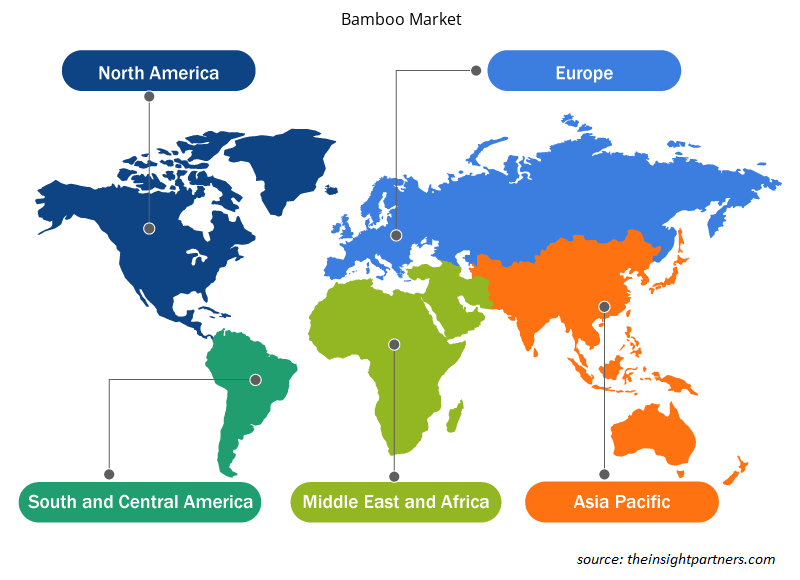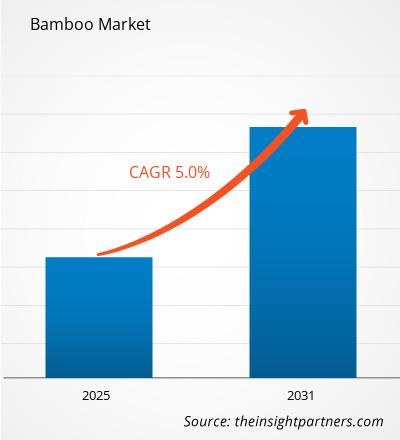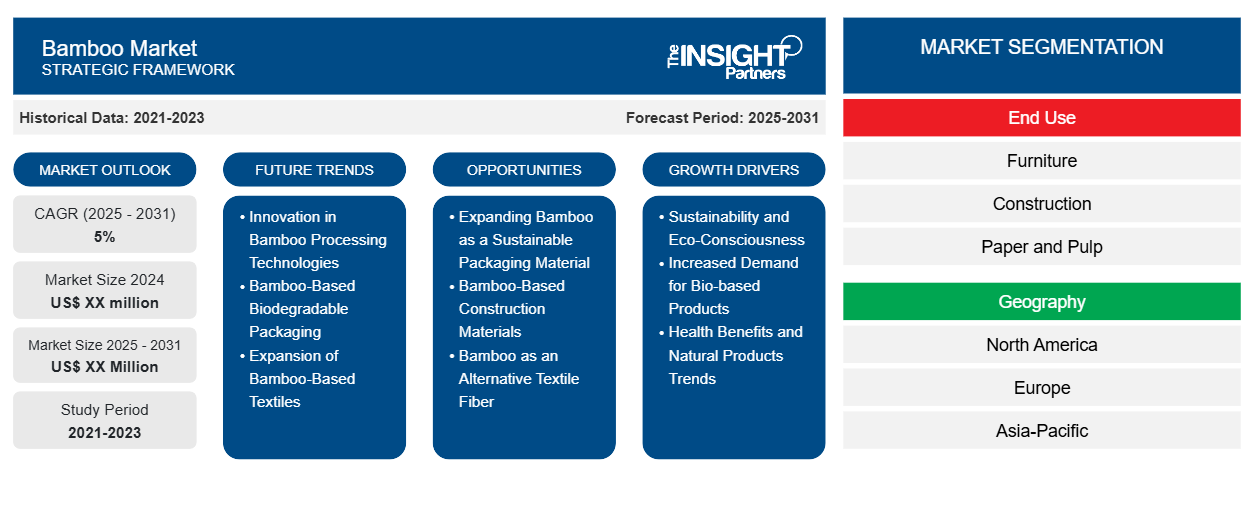预计竹子市场在 2023 年至 2031 年期间的复合年增长率为 5%,市场规模将从 2023 年的 XX 百万美元扩大到 2031 年的 XX 百万美元。
报告根据最终用途(家具、建筑、造纸和纸浆、生物质、纺织品等)进行分析。全球分析进一步细分为区域和主要国家。全球分析进一步细分为区域和主要国家。范围涵盖所有关键细分市场的全球、区域和国家层面的市场规模和预测。报告以美元为单位提供上述分析和细分市场的价值。报告提供了主要市场参与者的市场状况的关键统计数据,并提供了市场趋势和机会。
报告目的
The Insight Partners 发布的《竹子市场》报告旨在描述竹子市场的现状和未来增长、主要驱动因素、挑战和机遇。这将为各业务利益相关者提供见解,例如:
- 技术提供商/制造商:了解不断变化的市场动态并了解潜在的增长机会,从而能够做出明智的战略决策。
- 投资者:对市场增长率、市场财务预测以及整个价值链中存在的机会进行全面的趋势分析。
- 监管机构:监管市场政策和警察活动,旨在最大限度地减少滥用行为,维护投资者的信任和信心,维护市场的完整性和稳定性。
竹子市场细分
最终用途
- 家具
- 建造
- 纸张和纸浆
- 生物质
- 纺织品
- 其他的
定制此报告以满足您的需求
您可以免费定制任何报告,包括本报告的部分内容、国家级分析、Excel 数据包,以及为初创企业和大学提供优惠和折扣
-
获取此报告的关键市场趋势。这个免费样品将包括数据分析,从市场趋势到估计和预测。
竹子市场增长动力
- 可持续性和生态意识:竹子被认为是木材、塑料和金属等传统材料的环保替代品。随着人们对森林砍伐、气候变化和塑料废物的担忧日益增加,竹子的可再生特性使其成为家具、纺织和建筑行业的一个有吸引力的选择。消费者对可持续产品的日益偏爱推动了对竹制品的需求。
- 生物基产品需求增加:随着全球向可持续和环保替代品的转变日益加剧,竹子越来越被视为包装、纺织品和其他消费品的可行解决方案。这种材料的多功能性,加上其对环境的影响极小,推动了其在各个领域的应用,包括可生物降解的包装和家具。
- 健康益处和天然产品趋势:竹子因其低过敏性、抗菌和天然抗菌特性,在注重健康的市场中越来越受欢迎。这导致它被纳入纺织品、个人护理产品和健康用品中,如竹制牙刷和床上用品。随着消费者越来越重视健康产品,对竹制替代品的需求也在增长。
竹子市场未来趋势
- 竹子加工技术创新:先进加工技术的发展使人们能够生产出更高质量的竹产品,例如更坚固耐用的纺织品、地板和建筑材料。这些创新有望扩大竹子在高性能建筑材料和环保包装等新应用领域的市场。
- 竹制可生物降解包装:随着人们对塑料污染的担忧日益加剧,竹子正成为可生物降解包装解决方案的可行替代品。随着越来越多的公司转向可持续做法,对竹制包装的需求预计将上升,特别是在食品和消费品领域,这使得竹子成为循环经济的关键材料。
- 竹纤维纺织品的扩张:竹纤维因其柔软、耐用和可持续性而越来越多地用于纺织行业。随着消费者对更环保的服装和家纺的需求不断增加,竹纤维等竹纤维面料的市场预计将增长。这一趋势受到人们对可持续时尚意识的不断增强的推动。
竹子市场机遇
- 扩大竹子作为可持续包装材料的应用:全球对可持续发展的推动为竹子在包装领域的应用提供了重大机遇。随着越来越多的行业寻求塑料的环保替代品,竹子的快速生长和生物降解性使其成为包装材料的诱人选择,尤其是在食品和饮料行业。
- 竹制建筑材料:竹子的耐用性和强度使其成为可持续建筑的理想材料。人们对绿色建筑实践和环保基础设施建设的日益关注为竹子在建筑行业提供了巨大的市场机会,尤其是在新兴市场,那里对经济实惠、环保住房的需求正在增加。
- 竹子作为替代纺织纤维:随着消费者对可持续时尚的认识不断提高,竹子正成为棉花和合成纤维等传统纺织品的首选替代品。可持续时尚运动的发展为竹纤维在服装、家纺和其他织物产品中的应用提供了机会,推动了市场扩张。
竹子市场区域洞察
Insight Partners 的分析师已详细解释了预测期内影响竹子市场的区域趋势和因素。本节还讨论了北美、欧洲、亚太地区、中东和非洲以及南美和中美洲的竹子市场细分和地理位置。

- 获取竹子市场的区域特定数据
竹子市场报告范围
| 报告属性 | 细节 |
|---|---|
| 2023 年的市场规模 | XX 百万美元 |
| 2031 年市场规模 | XX 百万美元 |
| 全球复合年增长率(2023 - 2031) | 5% |
| 史料 | 2021-2022 |
| 预测期 | 2024-2031 |
| 涵盖的领域 |
按最终用途
|
| 覆盖地区和国家 |
北美
|
| 市场领导者和主要公司简介 |
|
竹子市场参与者密度:了解其对商业动态的影响
竹子市场正在快速增长,这得益于终端用户需求的不断增长,这些需求源于消费者偏好的不断变化、技术进步以及对产品优势的认识不断提高等因素。随着需求的增加,企业正在扩大其产品范围,进行创新以满足消费者的需求,并利用新兴趋势,从而进一步推动市场增长。
市场参与者密度是指在特定市场或行业内运营的企业或公司的分布情况。它表明在给定市场空间中,相对于其规模或总市场价值,有多少竞争对手(市场参与者)存在。
在竹子市场运营的主要公司有:
- MOSO 国际有限公司
- 大庄集团
- 上海天宝竹纺织有限公司
- 竹村有限公司
- 厦门恒邦达工贸有限公司
免责声明:上面列出的公司没有按照任何特定顺序排列。

- 了解竹子市场主要参与者概况
主要卖点
- 全面覆盖:报告全面涵盖了竹子市场的产品、服务、类型和最终用户的分析,提供了整体概况。
- 专家分析:报告基于对行业专家和分析师的深入了解而编写。
- 最新信息:该报告涵盖了最新信息和数据趋势,确保了其与业务的相关性。
- 定制选项:此报告可以定制以满足特定客户要求并恰当地适应业务策略。
因此,竹子市场研究报告有助于引领解读和了解行业情景和增长前景。尽管可能存在一些合理的担忧,但本报告的总体优势往往大于劣势。
- 历史分析(2 年)、基准年、预测(7 年)及复合年增长率
- PEST和SWOT分析
- 市场规模、价值/数量 - 全球、区域、国家
- 行业和竞争格局
- Excel 数据集
近期报告
客户评价
购买理由
- 明智的决策
- 了解市场动态
- 竞争分析
- 客户洞察
- 市场预测
- 风险规避
- 战略规划
- 投资论证
- 识别新兴市场
- 优化营销策略
- 提升运营效率
- 顺应监管趋势























 获取免费样品 - 竹子市场
获取免费样品 - 竹子市场